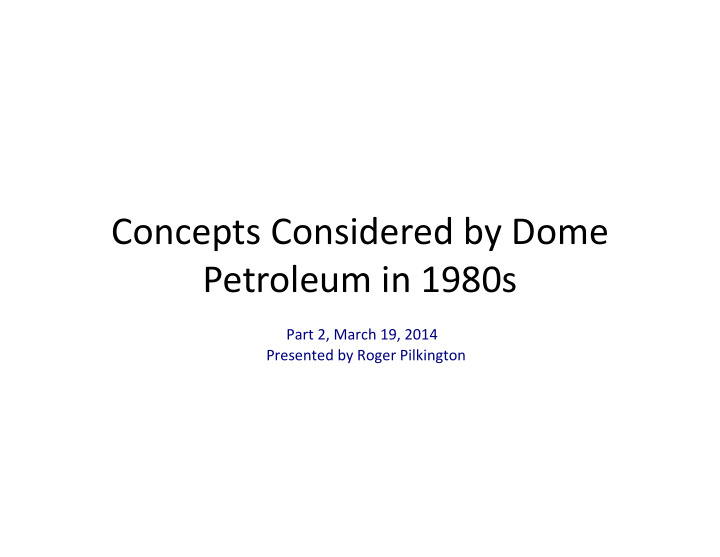



Concepts Considered by Dome Petroleum in 1980s Part 2, March 19, 2014 Presented by Roger Pilkington
Operating drillship in landfast ice
Dome’s Production Concepts from 1980s (from FG Bercha)
Mono ‐ Cone Production Structure proposed for Beaufort, Dome 1978 (drawing by FG. Bercha)
Arctic Production Monocone Designed to be disconnected (drawing by FG Bercha)
Loading Structure Proposed by Dome Pet. for Production in Beaufort Sea
Production Loading GBS of the 1970s
Operating Production Systems
Molikpaq at Sakhalin Island Sakhalin Energy Investment Corporation Early production using SALM, FSO and offloading tanker
Sakhalin II Piltun ‐ Astokhskoye ‐ B (PA ‐ B) GBS, Sakhalin Energy
Sakhalin Development Sakhalin Energy
CIDS – Exxon Neftegaz Production structure at Orlan off Sakhalin Island
Hibernia Icebergs very little pack ice
White Rose and Terra Nova FPSOs used on Grand Banks. (Husky & Petro ‐ Canada) • Icebergs but little pack ice
Prirazlomnaya platform Pechora Sea. Gasprom Verandey Tanker loading structure. Pechora Sea Lukoil ‐ ConocoPhillips
Bay of Bohai structure Sakhalin-1 De-Kastri Terminal in Khabarovsk Krai , West of Sakhalin Island, Russia. Single Point Mooring facility (SPM) loads tankers year round. Exxon Neftegas Ltd
Recent Concepts for Production Systems in Arctic Waters
Huisman JBF Arctic operates in open water (semi ‐ sub), in ice (Kulluk like) and as GBS
ExxonMobil Hebron GBS Designed to withstand sea ice, icebergs, and wave conditions
Exxon Half ‐ cone GBS ConocoPhillips GBS
ConocoPhillips Deep Arctic Floater
GustoNSC Nanu Q 5000 Inocean IN ‐ ICE Drillship
Platform ‐ free oil in Arctic waters within striking distance By Balazs Koranyi, Reuters | January 7, 2013 • “By the time the real Arctic fields in the ice ‐ infested waters of Alaska and Siberia are ready for development, the technology will be there for platform ‐ free production,” says Tore Halvorsen, the subsea chief of FMC Technologies. • “The game changer is to have fluid extracted, processed and directly exported from the field without intervention from a platform… We’re not far from that.”
Conclusions • The concepts used in the Beaufort were very innovative at the time • Thanks to these pioneering years, many new concepts have been developed, and oil and gas is being developed safely and economically in the arctic. • We can clearly expect to see many more interesting developments in the future.
Some of Field Projects conducted in 1970s to 90s Name of Project Year conducted Purpose Esso Ice Test Basin 1970s Ken Croasdale and others conducted small to medium size ice impact tests in Esso’s ice basin on 58 th Ave and 4 th St SE, Calgary Arctic Joint Ice Dynamics 1972 Study of ice, atmosphere and ocean interaction. Large camp on Project (AIDJEX) ice for many years. Mainly U of Washington IB Kigoriak test program 1979 Test icebreaker in pack ice in winter. Believed to be first ice breaker to venture into shear zone in Beaufort in winter Beaufort Field Tests 1970 to 90 Large number of field tests to investigate ice thickness, drift speed, land fast ice movement, MY and FY ridge heights and numbers, extreme ice features, ice islands, ice strength, etc Tarsuit Island Research Projet 1982/83 Profile rubble field, measure in ‐ ice pressures and ice movements Bryam Martin Indentation 1984 Indentation tests carried out to measure strength of MY ridge ice. Indenter areas up to 2.5m 2 . Tests Hans Island 1980 and 1981 Ice floe impact against a small island in Kennedy Channel to get full scale ice pressures for ice impact on structures. See slides below. Pack Ice Driving Force 1986, 89, 91 Field projects to measure peak pack ice forces associated with Projects ridge building. Exxon Large Beam Strength Winter 1979/80 13 large scale ice strength tests were conducted offshore Prudhoe Tests Bay, to determine uni ‐ axial compressive strength of ice.
Arctic R & D Organizations since 1970s Organisation # Reports Types of Studies Esso, Dome, Gulf, Sun, Dozens A lot of R&D was done by oil companies themselves. All had large Arco, Exxon, Shell, etc research departments and carried out projects relevant to their own needs. APOA 222 Formed in 1970 to conduct joint industry studies of common interest. Ended in 1985. Most or all studies are in AINA at U of C. AOGA Hundreds Similar to APOA but for Alaska. Still operational Environmental Studies 162 Started 1983. Funded by oil companies from levies on frontier Research Funds (ESRF) lands. Covers Environmental and Social Studies. Reports free ‐ NEB. Program of Energy Hundreds Federal Interdepartmental program operated by NRCan. Started in Research and 1972 ‐ ongoing. In 2009, funding $55 million per year; but only Development (PERD) portion is Beaufort related. Most reports are public and on web. Beaufort Environmental 7 vols Dome, Esso, and Gulf prepared the EIS in 1982 for potential oil and Impact Statement (EIS) gas production in the Beaufort. Reviewed plans and considered impacts. NRC Snow and Ice 11 Started in 1953 and lasted to 1988. Sponsored workshops on a Subcommittee range of topics. R&D Review Reports 5 Reports written in the 1990s to 2005 to identify critical research issues for offshore development in the Beaufort Sea.
The shuttle tanker Kometik transports oil from the Hibernia platform to the Transshipment Terminal at Whiffen Head,
Location of Hans Island
MY Floe Hitting Hans Island
Where are they now? • Sand and gravel islands eroded to halocline ( ‐ 10m) • Dome drillships 1 ‐ 3 probably scrapped. Exp 4 in use • Gulf Kulluk purchased by Shell. Being scrapped • Gulf Molikpaq converted to production structure in Far East Russia (Gazprom/Shell) • Tarsiut caissons in Arctic and available for $1 (negotiable) • Esso CRI? I think still in Tuk harbour • Dome SSDC available for lease in Arctic • Global Marine CIDS is now production platform in FER for Exxon Neftigaz (Orlan)
Recommend
More recommend